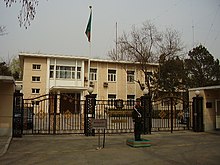China–Zambia relations
The Zambian government began to invest in transportation infrastructure, to help the economic growth of the country and support political freedom movements in the region of the Southern African Development Community.[2] This reflects a wider interest of China during this period, in which it began its planning to aid African countries with infrastructural development and political support.Zambia in the early 1990s, implemented a multiparty democratic system whereas in China there was a recovery period from economic and social challenges due to the Cultural Revolution, followed by the Open-Door Policies of Deng Xiaoping.This forum aimed to facilitate and promote cultural exchange, economic cooperation, joint trust, and political equivalence to drive the relationship.[6] The Chinese investors had complaints, as a Zambian newspaper reported: “the Zambian government’s rigid control over expatriate staff, high transportation costs due to its landlocked position and poor infrastructure, discriminatory incentives, complicated labour relations laws, frequent strikes by workers, and poor local industries were not helping investors.”[7]: 5 After recognising the People's Republic of China (PRC) just after 5 days following its establishment in 1949, Zambia has been one of China's oldest diplomatic partners.This is required to meet President Hakainde Hichilema's goal of spurring economic growth by tripling national copper production to three million tonnes per year.[22] The largest venture between ZESCO and SinoHydro is the Kafue Gorge Lower Power Station (KGL), a hydroelectric dam along the Zambezi River near Zambia's southern border with Zimbabwe.Originally planned to be operational by 2020, the project stalled amidst concerns about Zambia and ZESCO's ability to fulfil their debt obligations to China's EximBank and ICBC.[25] Amos Chanda, a spokesman for the Zambian President, refuted such claims by U.S. National Security Advisor John Bolton in 2018, stating ZESCO is by no means collateral for Zambia's debt to China.[27] The 2006 presidential election showed a good representation of the anti-Chinese sentiment in Zambia, with political figure Sata (who then became president later in 2011) gaining a lot of popularity using his anti-PRC rhetoric as his main approach.With opposition candidate Michael Sata taking an anti-PRC stance, stating that were he to win the election, he would renounce Zambia's recognition of the PRC and recognize the Republic of China in Taiwan.In February 2007 the Chinese government sought to mitigate anti-PRC feeling in Chambishi by promising to invest US$800 million into the creation of a China-Zambian economic zone and help the country to industrialize.[7]: 5 In July 2019, UN ambassadors of 37 countries, including Zambia, signed a joint letter to the United Nations Human Rights Council defending China's persecution of Uyghurs.
Zambiacurrent and historical relationshipPeople's Republic of ChinaGo Out policyForum on China–Africa CooperationAfrica–China economic relationsChina Non-Ferrous Metals CorporationPresident Hakainde Hichilema'sSinoHydroKafue Gorge Lower Power StationKafue Gorge Lower Power Station (KGL)Kafue Gorge Upper Station (KGU)China's Export-ImportIndustrial and Commercial BanksSinosureU.S. National Security Advisor John Boltonanti-Chinese sentimentanti-PRCCollum Coal Mine2006 Zambian presidential electionsMichael SataRepublic of ChinaLevy MwanawasaUnited Nations Human Rights CouncilChina's persecution of UyghursHong Kong national security lawUnited NationsCardenal, Juan PabloAraújo, HeribertoShinn, David H.Columbia University PressWayback Machineunskilled wageThe DiplomatReutersForeign relations of ChinaAlgeriaAngolaBotswanaBurkina FasoBurundiCameroonCape VerdeCentral African RepublicComorosCongo, Democratic Republic of theCongo, Republic of theDjiboutiEquatorial GuineaEritreaEthiopiaGambiaGuineaGuinea-BissauIvory CoastLesothoLiberiaMadagascarMalawiMauritaniaMauritiusMoroccoMozambiqueNamibiaNigeriaRwandaSão Tomé and PríncipeSenegalSeychellesSierra LeoneSomaliaSouth AfricaSouth SudanTanzaniaTunisiaUgandaZimbabweAntigua and BarbudaArgentinaBahamasBarbadosBoliviaBrazilCanadaColombiaCosta RicaDominican RepublicEcuadorEl SalvadorGrenadaHondurasJamaicaMexicoNicaraguaPanamaSurinameTrinidad and TobagoUnited StatesUruguayVenezuelaAfghanistanArmeniaAzerbaijanBangladeshBhutanBruneiCambodiaEast TimorGeorgiaIndonesiaIsraelhistoryKazakhstanKyrgyzstanLebanonMalaysiaMaldivesMongoliaMyanmarNorth KoreaPakistanPalestinePhilippinesSaudi ArabiaSingaporeSouth Korea